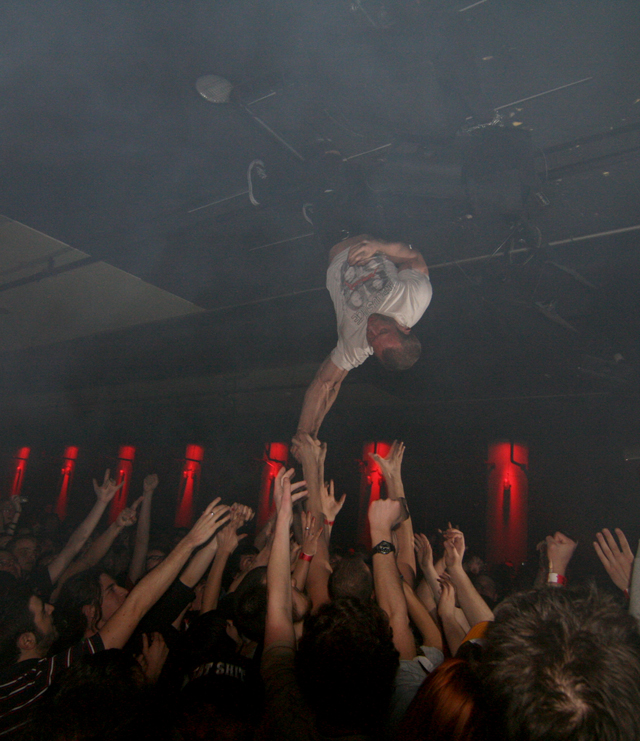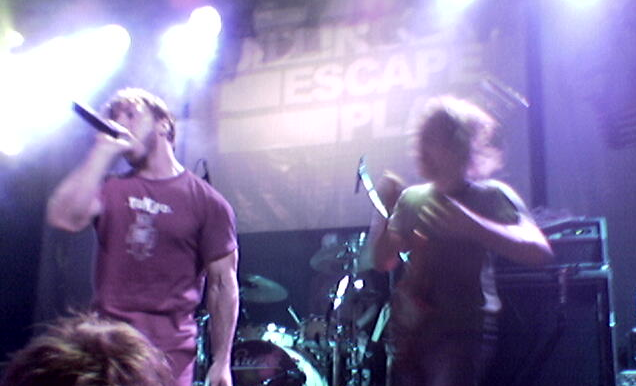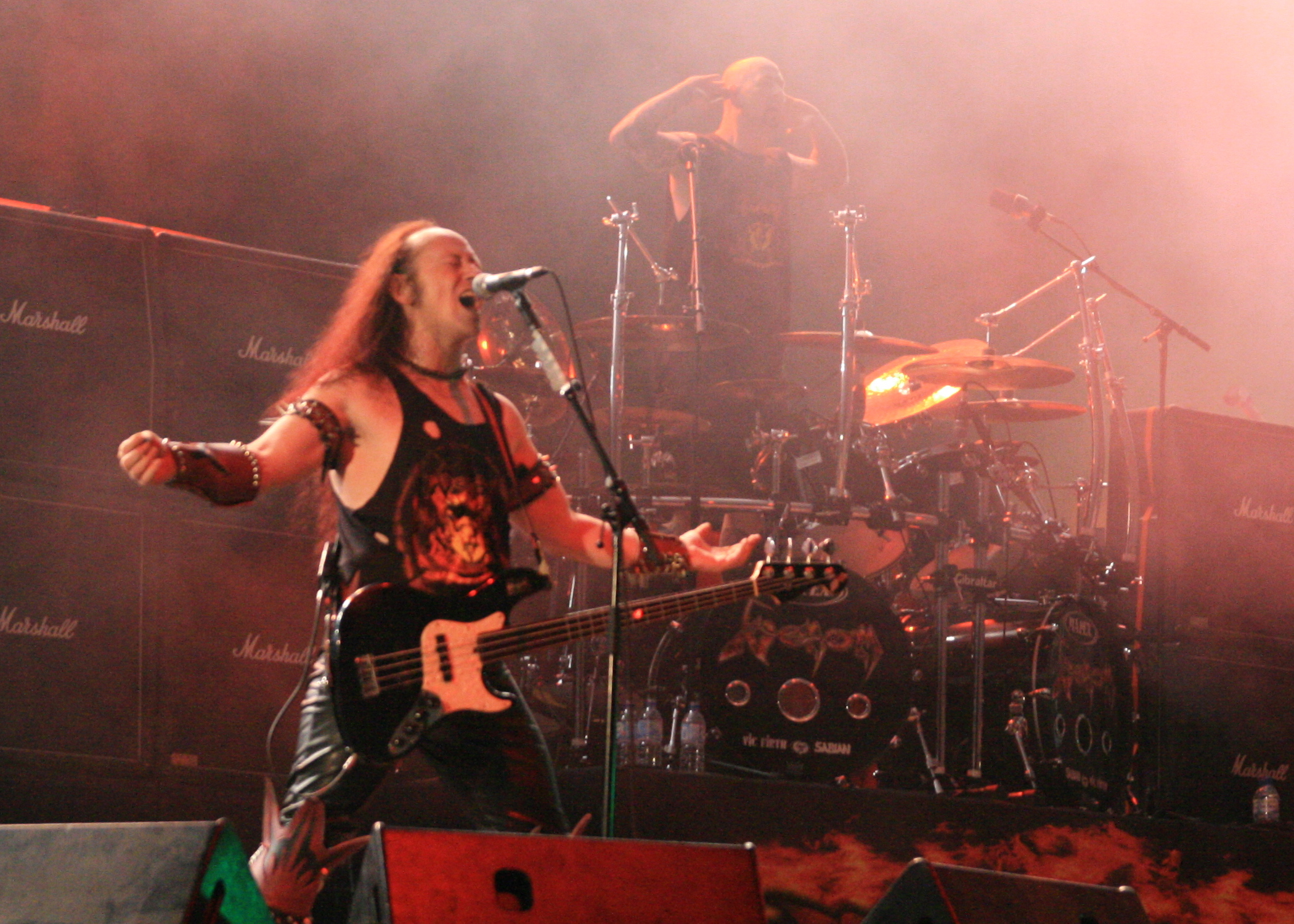|
Mathcore
Mathcore is a subgenre of hardcore punk and metalcore influenced by post-hardcore, extreme metal and math rock that developed during the 1990s. Bands in the genre emphasize complex and fluctuant rhythms through the use of irregular time signatures, polymeters, syncopations and tempo changes. Early mathcore lyrics were addressed from a realistic worldview and with a pessimistic, defiant, resentful or sarcastic point of view. In the 1990s, the hardcore punk scene started to embrace extreme metal openly. It also started to become highly ideological, with most of the popular bands being part of subcultures. This led to bands such as Converge, Botch, Coalesce and The Dillinger Escape Plan to establish the genre. Characteristics Music Mathcore emphasizes complex and fluctuant rhythms through the use of irregular time signatures, polymeters, syncopations and tempo changes, while at the same time the drummers play with overall loudness. In the words of The Dillinger Escap ... [...More Info...] [...Related Items...] OR: [Wikipedia] [Google] [Baidu] |
Metalcore
Metalcore (also known as metallic hardcore) is a fusion music genre that combines elements of extreme metal and hardcore punk. As with other styles blending metal and hardcore, such as crust punk and grindcore, metalcore is noted for its use of breakdowns, slow, intense passages conducive to moshing. Other defining instrumental qualities include heavy riffs and stop-start rhythm guitar playing, occasional blast beats, and double bass drumming. Vocalists in the genre typically use thrash or scream vocals. Some later metalcore bands combine this with clean singing, often during the chorus. Death growls and gang vocals are common. 1990s metalcore bands were inspired by hardcore while later metalcore bands were inspired by melodic death metal bands like At the Gates and In Flames. The roots of metalcore are in the 1980s when bands would combine hardcore punk with heavy metal. This included New York hardcore bands like Agnostic Front, Cro-Mags, and Killing Time, British ... [...More Info...] [...Related Items...] OR: [Wikipedia] [Google] [Baidu] |
The Dillinger Escape Plan
The Dillinger Escape Plan was an American metalcore band. The band was formed in 1997 in Morris Plains, New Jersey by guitarist Ben Weinman, bassist Adam Doll, vocalist Dimitri Minakakis, and drummer Chris Pennie. The band's use of odd time signatures, polyrhythms and unconventional drum patterns became a staple of their sound, although later albums incorporated more melody, and influences from a range of genres. The band's lineup shifted numerous times throughout its existence; by the time the group dissolved, Weinman was the only remaining founding member. The last surviving lineup also included longtime members Liam Wilson on bass, Greg Puciato as lead vocalist, and Billy Rymer on the drum kit, alongside then-newcomer Kevin Antreassian as rhythm guitarist. The Dillinger Escape Plan achieved critical success, releasing six studio albums during its existence, the first being ''Calculating Infinity'' (1999), which has been noted by critics as a landmark release in hardcore punk a ... [...More Info...] [...Related Items...] OR: [Wikipedia] [Google] [Baidu] |
Grindcore
Grindcore is an extreme fusion genre of heavy metal and hardcore punk that originated in the mid-1980s, drawing inspiration from abrasive-sounding musical styles, such as thrashcore, crust punk, hardcore punk, extreme metal, and industrial. Grindcore is considered a more noise-filled style of hardcore punk while using hardcore's trademark characteristics such as heavily distorted, down-tuned guitars, grinding overdriven bass, high-speed tempo, blast beats, and vocals which consist of growls, shouts and high-pitched shrieks. Early groups like Napalm Death are credited with laying the groundwork for the style. It is most prevalent today in North America and Europe, with popular contributors such as Brutal Truth and Nasum. Lyrical themes range from a primary focus on social and political concerns, to gory subject matter and black humor. A trait of grindcore is the "microsong" much shorter than average for punk or metal; several bands have produced songs that are only sec ... [...More Info...] [...Related Items...] OR: [Wikipedia] [Google] [Baidu] |
Math Rock
Math rock is a style of progressive and indie rock with roots in bands such as King Crimson and Rush as well as 20th-century minimal music composers such as Steve Reich. It is characterized by complex, atypical rhythmic structures (including irregular stopping and starting), counterpoint, odd time signatures, angular melodies, and extended, often dissonant, chords. It bears similarities to post-rock. Characteristics Math rock is typified by its rhythmic complexity, seen as ''mathematical'' in character by listeners and critics. While most rock music uses a meter (however accented or syncopated), math rock makes use of more non-standard, frequently changing time signatures such as , , , or . As in traditional rock, the sound is most often dominated by guitars and drums. However, drums play a greater role in math rock in providing driving complex rhythms. Math rock guitarists make use of tapping techniques and loop pedals to build on these rhythms, as illustrated by ... [...More Info...] [...Related Items...] OR: [Wikipedia] [Google] [Baidu] |
Extreme Metal
Extreme metal is a loosely defined umbrella term for a number of related heavy metal music subgenres that have developed since the early 1980s. It has been defined as a "cluster of metal subgenres characterized by sonic, verbal, and visual transgression". The term usually refers to a more abrasive, harsher, underground, non-commercialized style associated with the speed metal, thrash metal, black metal, death metal, and doom metal genres.K. Kahn-Harris, ''Extreme Metal: Music and Culture on the Edge'' (Berg Publishers, 2007), , p. 31. Hardcore punk has been considered an integral part of the development of extreme metal, in the case of song structure and speed, in every case other than doom metal. Definitions Extreme metal acts set themselves apart from traditional heavy metal acts, such as Iron Maiden, Judas Priest and Motörhead, by incorporating more abrasive musical characteristics such as higher tempos, increased aggression and a harsher extremity. In the majori ... [...More Info...] [...Related Items...] OR: [Wikipedia] [Google] [Baidu] |
|





